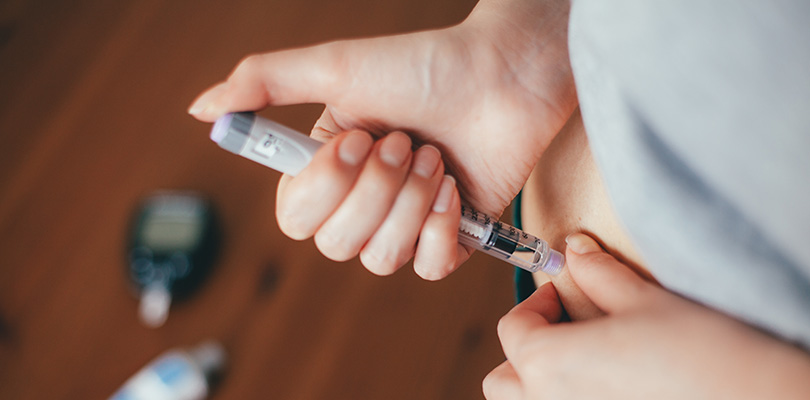Foot Ulcers and Diabetes
Foot ulcers are common among people with diabetes, affecting 10% to 15% of patients at some point in their lives. They are also an issue that diabetics must take seriously, as untreated foot ulcers can lead to amputation. This article explains the relationship between foot ulcers and diabetes, as well as how to recognize, treat and prevent them. Here’s all you need to know.
What Is a Foot Ulcer?
A foot ulcer is an area of damaged tissue on the foot. They can occur anywhere, but are most common under the big toes and balls of the feet.
Foot ulcers can develop from minor injuries, including cuts, blisters and even bruises. While these wounds might not cause much trouble for healthy individuals, they can be dangerous for people with diabetes. Let’s take a closer look at the link between foot ulcers and diabetes.
How Diabetes Can Cause Foot Ulcers
High blood sugar can damage blood vessels and nerve cells over time. Therefore, many people with diabetes suffer from poor circulation and nerve damage, also known as neuropathy.
Diabetes Can Slow the Body’s Healing Process
Together, these two factors can seriously hinder the healing process. Therefore, people with diabetes may find that damage to their skin repairs relatively slowly or abnormally. This increases the risk of infections and can allow small abrasions to develop into foot ulcers.
Numbness and Foot Ulcers
Furthermore, nerve damage can cause symptoms such as numbness in the feet. Therefore, people with neuropathy may not notice when they sustain foot trauma, such as stepping on a sharp object or rubbing shoes.
What Are the Risk Factors?
People with diabetes should check their feet daily. It is essential to identify any wounds and treat them immediately to avoid developing foot ulcers.
Some further risk factors for foot ulcers:
- Poorly controlled blood sugar
- Ill-fitting footwear
- Walking barefoot
- Poor hygiene practices
- Trimming the toenails too short
- Alcohol or tobacco consumption
- Heart or kidney disease
- Eye problems
- Obesity
Finally, the longer a person has had diabetes, the more likely they will be to develop foot ulcers.
Foot Ulcer Warning Signs and Symptoms
The early stages of a foot ulcer may not cause any pain. Therefore, it is necessary to recognize the visual warning signs that one could be developing:
- Lumps or swellings on the feet
- Redness or other discoloration
- Skin irritation
- Discharge that may stain the socks or shoes
Eschar and Gangrene
One of the key warning signs of foot ulcers is dark coloration around a wound. This is known as eschar and it is composed of dead skin tissue. It can indicate the beginning of gangrene, a serious complication that can lead to amputation. Other symptoms of gangrene:
- Pus or discharge
- A foul odor
- Numbness
- Pain
If any of these symptoms occur, seek medical treatment as soon as possible.
Injectable insulin is used to help control diabetic blood sugar levels. Read on to learn more about insulin for diabetes here.
Treatment for Diabetic Foot Ulcers
There are several different methods of treating diabetic foot ulcers depending on their severity and where they occur.
Off-Loading
One of the most common foot ulcer treatments is off-loading. It involves taking the pressure off the affected foot, either by using a plaster cast, foot brace, or special shoe. This treatment is especially helpful for ulcers on the sole of the foot. It allows them to heal without being constantly aggravated by walking and standing.
Debridement
Debridement is the medical term for clearing dead tissue or foreign objects from a foot ulcer to prevent infection. Doctors may do this surgically or using enzymes that dissolve the damaged cells. In some cases, specialists may even use maggots to debride a wound.
Antibiotics
Antibiotics are an important treatment method for foot ulcers as they prevent bacterial infections from spreading. It is essential to take them exactly as directed and complete the full course.
Dressings
Dressings help to keep foot ulcers clean and prevent infections. Some contain ingredients like calcium alginate that help to speed up the healing process. Patients should wash and dry their hands thoroughly and clean the affected area before applying dressings. It is also important to change them regularly.
Compression
Compression wraps or stockings improve circulation in the feet and legs. They reduce swelling and promote faster healing. They also help to keep dressings in place. Compression garments should be tight enough to encourage healthy blood flow but not so much that they cause pain. Therefore, it is advisable to have them fitted by a professional.
Diabetic Foot Ulcer Prevention Methods
The best way to avoid diabetic foot ulcers is checking the feet daily for signs of injury or infection. Some other effective foot ulcer prevention methods:
- Wash the feet daily and dry them thoroughly
- Change the socks at least daily
- Keep the toenails trimmed but not too short
- Wear comfortable footwear that fits properly
- Do not walk barefoot
- See a podiatrist regularly
- Maintain a healthy body weight
- Keep alcohol consumption to minimum
- Do not smoke
In Review
It is critical that people with diabetes manage their condition properly. This will minimize the risk of damaging blood vessels and nerves with high blood sugar, thus making foot ulcers less likely.
Eat well, get plenty of exercise and monitor glucose levels regularly. Finally, if any foot ulcer symptoms occur, seek medical attention.







